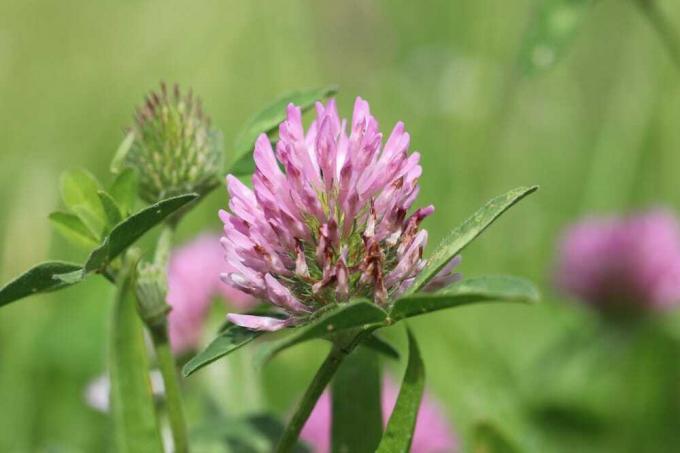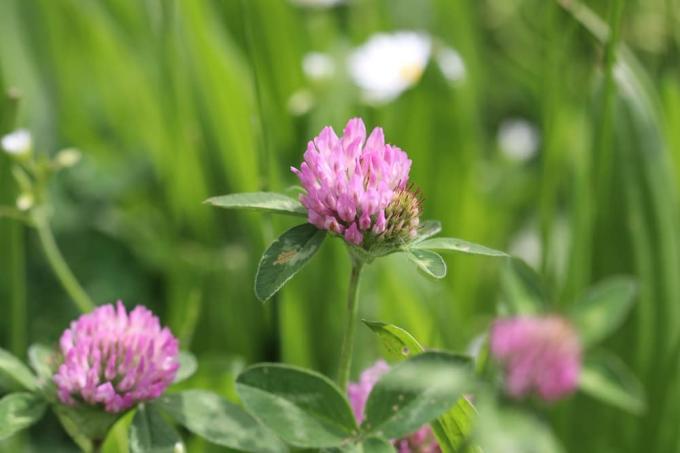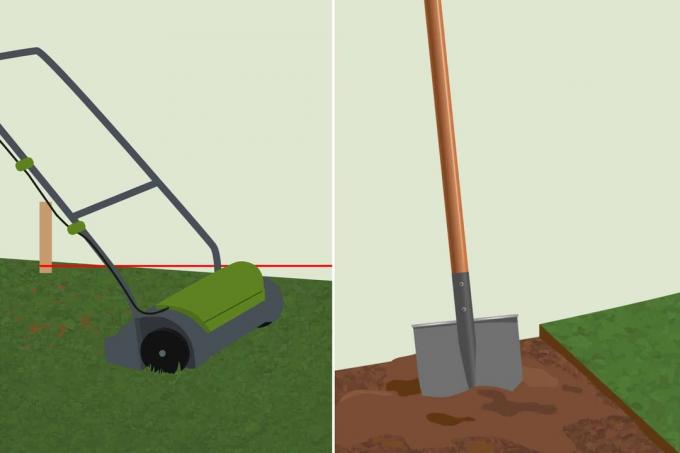

Table of contents
- Occurrence and identification features
- causes
- Systematic approach
- 1. Manual emergency measures
- scarify
- Cut out by hand
- 2. changing soil conditions
- Preferred location and soil conditions of red clover
- Measures
- Fertilize the lawn properly
- spray
- radical solution
- Plastic tarpaulin against clover
- Conclusion
The insects love it - but for the gardener the red clover is often worse than the plague. Once it has settled in the lawn, it can only be removed with great difficulty. Its long spurs creep through the grass, taking up space and light until there is little left of the once beautiful lawn. Read this article to learn how to get rid of red clover in your lawn.
Occurrence and identification features
The red clover, also called meadow clover, is a plant native to us. Their natural occurrence extends from Europe to central Asia. The plant feels at home on nutrient-rich roadsides, on meadows and forest clearings. In the highlands it can be found up to 2500 meters. Trifolium pratense belongs to the clover genus (Trifolium), in which more than 200 different species of the herbaceous plant occur. The perennial meadow clover can reach heights of growth of up to 60 cm, although it usually becomes much smaller in its natural environment. On lawns that are mowed regularly, it only moves slightly above ground level. Its leaves are arranged in groups of three (tri meaning three, folium leaf) at the tip of the leaf stalk. The light grain in the middle of each leaf is particularly striking. During the flowering period between the beginning of May and mid-October, the red clover forms spherical inflorescences that are equipped with up to 100 individual pink flowers. There are different varieties of red clover, which are named after their main area of distribution.
- Coast clover (Trifolium pratense subsp. maritime)
- Alpine clover (Trifolium pratense subsp. nival)
- Common meadow clover (Trifolium pratense supsp. pretense)
Red clover is one of the beneficial plants for humans and animals, because the herbaceous plant is an important source of pollen for insects and a forage plant for grazing cattle. Last but not least, the red clover helps to alleviate symptoms in medicine. But the plants are not welcome in every garden. Red clover quickly becomes a competitor in lawns and over time displaces it. Barren and sandy locations are particularly affected.
causes
A lawn should be free of weeds if possible. This not only looks a lot neater, but is also a sign of healthy grasses with strong roots. If clover settles in the lawn, this is a clear indication that the natural balance is disturbed. The causes of such a malfunction include:
- Soil pH is too high
- the nutrient content in the soil is not optimal
- the lawn is not properly cared for
Too high pH values mean that the red clover finds ideal growth conditions. If the grasses in the lawn are weakened, the robust meadow clover can assert itself better and multiply undisturbed. It is therefore important to create optimal conditions for the lawn grasses so that they can permanently return to their old form. Some of these measures are part of normal lawn care anyway. They not only ensure that the lawn is strengthened, but also that the meadow clover is eliminated at the same time.
Systematic approach
In contrast to white clover, which is relatively easy to remove from the lawn, red clover is much more stubborn. While the herbaceous plant with its reddish flowers is a pretty sight on natural meadows, it should not even gain a foothold in the edge areas of the lawn. Red clover is a distinctive deep-rooting plant that forms a long taproot that can reach up to two meters deep into the ground. It spreads by underground runners called rhizomes. The trick is that root pieces and offshoots remaining in the soil usually sprout again after a short time. It is therefore most effective to systematically remove the red clover from the lawn. A combination of different control variants is recommended for this purpose.
1. Manual emergency measures
Depending on how much meadow clover is already running through the lawn, the grass should be mowed low and scarified thoroughly. Connected areas of red clover should first be cut out by hand and removed as far as possible. It is best to fill these bare spots immediately with new lawn seed from a reseeding mixture. In order for the seeds to germinate and grow well, it is important to keep these areas of the lawn well moist. The ideal time for this is spring. It is also possible and sensible to remove the meadow clover during the rest of the growth period.
scarify
Since heavy weed growth inhibits the growth of the lawn, something must be done about it urgently. An efficient method of preventing heavy clover growth is scarifying. This mechanical removal of lawn thatch not only frees the lawn from meadow clover, but also from dead blades of grass and disturbing moss, so that the grass can breathe more receive. Scarifying also loosens the soil, allowing water and oxygen to reach the grass roots unhindered.
- Time: spring
- Process the affected areas several times
- use electric or petrol scarifiers for large areas
- Fill in bare spots with grass seed
- water well and fertilize
Cut out by hand

Merely mowing the lawn is not an effective way to remove clover from the lawn. The manual removal of the red clover should therefore begin as early as spring. Due to the high expenditure of time and the physical strain, a purely manual removal of red clover is only recommended for small areas. In principle, you do not need any special tools to get the red clover out of the lawn. Normally, a longer kitchen knife is sufficient. If you don't want to work on the lawn on your knees, you can get a special weed puller. These narrow miniature spades in the shape of a shoehorn are also available with a long handle. Since it is usually not possible to dig up the entire root, the procedure has to be repeated regularly. To strengthen the grass, some fertilizer is then applied and new grass seed may be sown on the bare patches.
Tip:
If a large part of the meadow clover is not removed mechanically first, all other attempts to combat the red clover are more or less ineffective. Therefore, a gardener cannot help but lend a hand to drive the clover out of the lawn permanently.
2. changing soil conditions
If a large part of the unloved meadow clover has been removed, this does not mean that it will remain so in the long term. If the same conditions prevail as before, it usually comes back after a short time. In order to limit its reappearance, the conditions for the weed should be made worse.
Preferred location and soil conditions of red clover
The ideal site conditions for the red clover are sunny to semi-shady locations and permeable, nutrient-rich soil.
- Light requirements: sunny to semi-shady
- nutrient-rich, well-drained soil
- moderately moist
- lime loving
- does not like very acidic soil
- With its deep roots, it also withstands longer periods of drought
Measures
Red clover's long taproot is one of the reasons why the herbaceous plant is so adaptable and also difficult to remove from the lawn. So it is unlikely that you will be able to completely get the clover out of the garden soil by scarifying or weeding alone. Therefore, something must be done at the same time for the lawn growth. Because in a healthy and strong lawn, the clover has few chances. As a rule, the garden soil, in which a lot of red clover grows in the lawn, is too calcareous (pH values over 7). In addition, it does not store enough water and the nutrients are not present in the optimal amount and ratio. So if the soil is made more lawn-friendly, this is a very effective measure against the meadow clover. With targeted fertilization, aeration of the lawn and optimization of the pH value in the soil, you create good growth conditions for the lawn.
- Lawn prefers a pH of 6.0 on light garden soil
- on heavy soils, a pH of 7.0 is ideal for the lawn
- Optimize soil pH
- if the soil is too calcareous, bring in suitable preparations to lower the pH value
- scarify in spring
- Fertilize the lawn (in the case of strong red clover growth only with special fertilizers)
- Water the lawn regularly when it is dry
- the ideal mowing height is around 4 cm

If the root felt is removed and the dense network is cut, the grasses get more air. Ideal conditions to assert yourself against your competitors and to form a closed turf again. Since the grass reacts much more sensitively to drought than meadow clover, the lawn has to be watered frequently during longer periods without rain. Also make sure the soil has an optimal pH value, because this is the only way for the grass to develop optimally and assert itself against the meadow clover. A common mistake made by amateur gardeners is liming the lawn without first determining the pH of the soil. As a result, they often increase the pH value considerably. Alkaline soil (calcareous) will degrade the conditions for the lawn. The red clover, however, feels really good.
Tip:
Have a soil sample checked by an appropriate institute and adjust the fertilization of the lawn based on the result. You may be able to get advice on this from a specialist retailer.
Fertilize the lawn properly
A good lawn fertilizer ensures that the grasses get everything they need. This is particularly necessary after the winter when the lawn will sprout again. Uniform growth is achieved through the nitrogen in the fertilizer. The lawn grows densely and evenly, which not only reduces the risk of burns in summer, but also helps to prevent red clover from growing wild. However, if you have large amounts of clover in your lawn, you should avoid using a universal fertilizer, as these often have too high a phosphate content, which in turn promotes clover growth. It is therefore advisable to use a slow-release fertilizer that provides high levels of nitrogen but very little to no phosphate.
- best time: just before a rainy season
- once in spring, once in summer (by the end of July at the latest)
- do not fertilize when the soil is dry and in the blazing sun
- fertilize early in the morning or better still in the late afternoon
- water the lawn beforehand
- before fertilizing, the blades of grass must be dry again
- Apply fertilizer evenly
- Amount according to package instructions
- preferably use slow-release fertilizers
- for example horn shavings or horn meal
- there are also special lawn fertilizers with a reduced phosphate content
- Lime the lawn only after a soil analysis
Tip:
In order to find exactly the right fertilizer for your soil conditions, you should have the soil analyzed. This is the only way to dose the nutrients in a targeted manner and prevent deficiency symptoms and over-fertilization.
spray
Another option, albeit not quite as environmentally friendly, can be pesticides to combat red clover in the lawn. There are now a number of effective clover killers available that do not damage the lawn and are not dangerous to bees. These remedies are based on destroying only dicotyledonous plants such as meadow clover, but not monocotyledons, i.e. grasses. The lawn stays that way while the red clover and some other weeds disappear.
- Always use pesticides exactly as instructed
- if possible, do not mow in advance
- the agent is preferably absorbed through the leaves
- use only on rainy days
- water the lawn again the evening before (before application).
Where the red clover dies, yellow patches naturally form in the lawn. Dead plants must be removed before sowing new lawn seeds. A light fertilization with phosphate-free fertilizer is then good for the lawn.
Tip:
When buying a lawn weed killer, pay attention to the area of application of the active ingredient. It should be explicitly noted that it works against red clover or all clovers (not just wood sorrel). Preparations against dicotyledonous weeds in the lawn are also suitable for combating red clover.
radical solution

If the stocking with meadow clover is excessive, a completely new lawn seeding may help. To do this, however, it is necessary to remove all roots from the soil in advance. This is the only way to ensure that red clover will not resettle. In some cases, the solution lies in a soil replacement.
- Time: spring or late summer
- Remove the soil to a depth of about 30 to 50 cm
- remove all roots and stones
- Put the soil through a coarse sieve several times, then a finer sieve
- prepare sifted soil with fresh humus or compost
- Spread the soil mixture back onto the surface
- condense
- pour on
- sow new lawn
Make sure that all roots and pieces of plants remain in the sieve, because new red clover can also grow from pieces of root. If you do not want to or cannot remove and replace the entire garden soil, you should try the following method:
Plastic tarpaulin against clover
A somewhat unusual, but very effective and environmentally friendly method of driving red clover out of a lawn is to cover a large area of the lawn with a plastic tarpaulin. This is spread over the areas of heavy clover growth for a period of a few weeks. As a result of the lack of light, the red clover dies.
Of course, the lawn also suffers from the conditions. However, it often recovers much better than the clover. If the grass also dies, that's not a problem, because the lawn can be overseed without any problems. However, before you seed a new lawn, the soil conditions must be improved, otherwise the red clover will also come back. So don't forget to fertilize.
Conclusion
Annual scarifying, regular mowing and watering in dry times, and balanced fertilization are usually enough to keep red clover out of the lawn. If it was able to settle, it must be removed by hand as soon as possible to prevent further spread. The conditions for the lawn should then be improved so that the grass can assert itself better against the weeds. However, the meadow clover will probably never disappear completely from the lawn. It is therefore important to come to terms with the weeds and to find a healthy middle ground.
 garden editorial
garden editorial I write about everything that interests me in my garden.
Learn more about lawn care

Leveling out unevenness in the lawn: this is how it works
Unevenness in the lawn is annoying and poses a danger to gardeners, playing children and pets. There are a number of methods that can be used to level the lawn. We present them to you in our guide.

Leveling the lawn: how to smooth uneven surfaces
Dents and holes in the lawn are unsightly. We will show you step by step how to smooth uneven areas in the lawn again.

Algae in the garden | Lawn is slippery: what to do?
Algae love rainy days. Can the water seep badly into the ground, even better! The green, slippery mass is not only not a pretty sight, but also a danger for the lawn. Only those who act preventively and correctly in acute cases can avoid permanent damage.

Fighting fungi in the lawn | 10 tips against fungal infestation
Mushrooms in the lawn are not uncommon but annoying and sometimes even dangerous. This is especially true if the garden or green space is also used by pets and children. Here we will show you how to combat fungal infestation.

Aerate the lawn | Before or after mowing?
Sun, water, fertilizer and air are necessary for the lawn to grow. If the lawn does not get enough air, it cannot grow properly. We clarify when the right time to ventilate the lawn is.

Mulching with lawn clippings: 13 things to consider
Keeping the lawn short is a must for many hobby gardeners. However, if the lawn mower does not have a mulching function so that the grass clippings can remain on the lawn, the question arises as to where to put the waste. Because the compost heap is not a good solution here.



